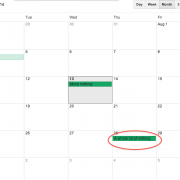Your Secret Treasure Trove of Customer Feedback
Your restaurant runs on customer feedback, right? If the chips are too salty, the fish too dry, the service too slow, or the wine selection too expensive, your customers will call you over and tell you. Immediately. If you think I’m delusional and you think that your customers would never tell you anything truthful about your food or service… well, you’re just not looking in the right places. Today’s post talks about the three main places you can find great customer feedback, and what you should look at.
Yelp
Yelp is the number one treasure trove of customer feedback for almost any business. When I’m looking for food on my travels and in my hometown, I usually check Yelp first to see who has the best reviews for a certain cuisine or location.
Google+
Google+ isn’t as large a resource for customer feedback, but since most people find your restaurant on Google, your Google+ reviews are usually the first thing that your customers see on the Web. Google+ may also have more reviews than Yelp in small towns, as for some reason small town people don’t like Yelping.
Urbanspoon
This app (and website) are filled with helpful information from actual foodies, and it tends to be an effective review site both in small towns and in large cities (and everything in between). Since Urbanspoon is more of a niche product for connoisseurs, the reviews on this app tend to be more helpful to people who look for restaurant subtleties such as décor, wine-list length, and overall atmosphere.
What to look for
Okay, so you know where to look, now you just need to know what to look for. Here’s what I search for as a customer, and I feel that this information gives me the most detailed information about a restaurant—without wasting too much time.
Total number of reviews: If more people have reviewed the place, I know that I will get an accurate picture of what the cuisine is like. When trusting an online review, I look for a restaurant that has at least 70 reviews.
Percentage of good reviews: When there are a lot of reviews and 80% are good, I’m more likely to just go there and trust that the place will be tasty.
One-star review details: When looking into a place, I don’t just want to know about the people who “loooooved” it, I want to know about the people who hated it. Frequently, I find that haters have really petty complaints such as “they only included three soy sauce packets with my delivery Chinese food,” or “they charged for refills on my herbal iced tea!” These people are clearly crazy, and in my mind, I adjust the average overall review to a higher percentage. Sometimes, though, people have legitimate concerns such as, “It was very nice of them to offer me $300 of free food, but after what I found in my already-partially eaten meal, I will never ever go back.” (That was a real review that I saw just last night.)
Most recent reviews: Restaurants go through transformations, and when they do, the reviews change as well. When I’m looking at a place I want to go to, I make sure to check into the most recent reviews of a place, so that I can determine if all of those five-star reviews that make the place look good were from two years ago (bad sign).
Should I get people talking about my restaurant more?
Yes! At this point, most restaurants ask their customers to follow them on Twitter or to friend them on Facebook, but few ask their customers to review them on Yelp (or other places). Perhaps restaurants are nervous that their customers will put bad reviews online, but in my opinion, restaurants should welcome and relish all of their reviews. Good reviews make your restaurant look stellar, and bad reviews let you know what to change TONIGHT. After you use Yelp, Google+, and Urbanspoon to check your number of reviews, percentage of good reviews, most recent reviews, and the details of your one-star reviews, you’ll have found the secret treasure trove of customer feedback—and all that feedback can help you take over the restaurant world by storm.
Photo licensed by Derrick Tyson
- Why Your Wine Menu Is Scaring Your Guests - February 27, 2015
- How to Host a Better Restaurant Week and Get More Customers - February 23, 2015
- Choosing Your Restaurant Wine Glass – 3 Approaches - February 16, 2015





